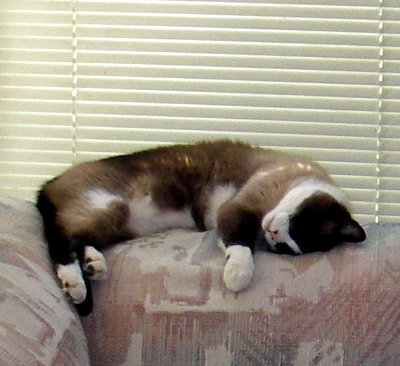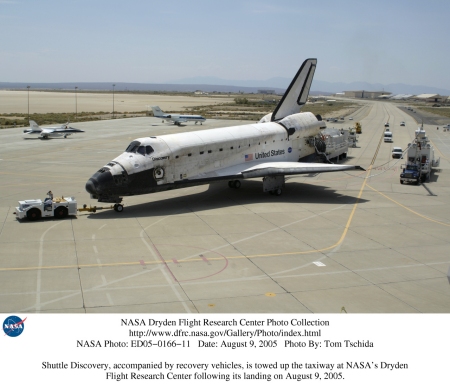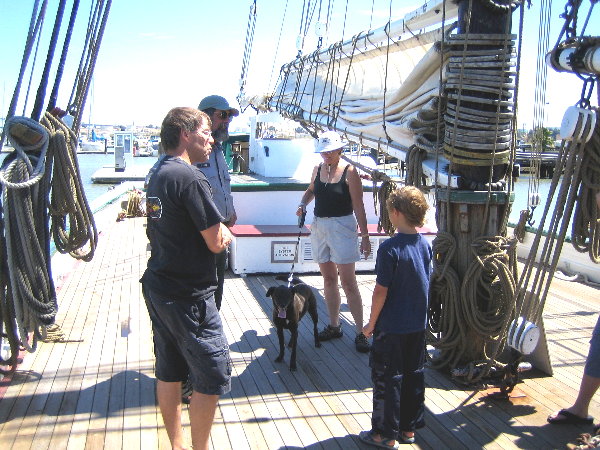;
Travels and Images
WEEK 32 2005
Last Week-
Sun- Mon- Tue- Wed- Thur- Fri- Sat- Next Week
Picture of the Week
MAIN PAGE
Saturday 13 August
2005
Saturday
- cooler weather than we've been having. There is a fire somewhere to
the west of us, and although it seemed to be blue skies all day that
might well have had an effect.
Update: Yep. A fire somewhere, you can smell it.
I've been thinking about Lormand's crossing, pondering a couple of points. He actually made two
attempts. On the first, some ways out to sea, he lost his working jib,
leaving him with only a storm jib and a genny, and decided to abort. It
seems a bit cautious, but it's better to err on the side of caution at
sea. On the second attempt Ed made it all the way across but then found
himself on a strange shore, without an engine, in a storm, at night,
unable to get into his chosen harbor at Plymouth. He uses the
lighthouse at Sark as a beacon - try's to get into the lee of the
island for shelter from the gale, and eventually damages his boat on
the nearby rocks. With the aid of some French fishermen he ends up at
the Isle of Jersey. I think he got lucky here, it is clear that
exhaustion and lack of sleep had affected his judgment.
Without modern navigational gear - LORAN or GPS or even working RDF -
he was, in bad weather, sailing using dead reckoning among rocks and
shoals. In theory he could have used the height of the light at Sark to
calculate his distance, as well as bearing, but at night in a gale and
a small boat this is probably asking too much. Should he have retraced
his course, tried to get back to open sea? I don't know - the area
around the Channel is heavily traveled by many ships and fisherman and
he had no radar, or even radar detector, to alert him to vessels on a
collision course, and it might be too much.
I guess the moral of the story is: Plan to arrive in the morning, rested, in broad daylight at an easy anchorage. Prepare to arrive in just the opposite conditions...
Friday 12 August
2005
Friday - warm, but not
too warm. The evaporative (swamp) cooler was able to keep the house
cool, no need to resort to the central a/c.
My morning walk went OK, though I didn't feel 100% and almost called it off.

Riley enjoys the new loveseat!
Another book I've read recently is How to Sail the Atlantic Alone, by Ed and Fran Lormand.
Books on sailing voyages, I've come to understand, have a certain order to them -
- the initial idea (dream),
- the decision to go,
- the preparation and planning,
- the departure,
- the bulk of the sailing,
- the arrival, and the aftermath.
I don't mind this ordering - it is undoubtedly an artifact of the
subject matter, and each stage has it's own appeal. I, for
example, am still at the first step, and it is taking of the second step that I found particularly interesting in this book.
To set the stage: Ed and Fran have been sailing for years, and have
been talking for years about Ed's dream of sailing across the Atlantic
single-handed. Family and friends have not, perhaps, been paying
attention...
Then all of a sudden the word became flesh. The dream turned into
reality on a beautiful weekend early in the spring of 1975. Ed and I,
along with a mixed group of family and friends, were weekending at my
mother's house, Sea Sand, at Fernandina Beach, Florida. From my place
at the dinner table I had an unobstructed view of low white dunes
anchored by gold sea oats bending in the breeze, and beyond that the
Atlantic Ocean tumbling gently onto the wide sandy beach.
"I am going to sail Folly from here to Plymouth, England," Ed announced, "to celebrate the Bicentennial."
"Pass the chicken," somebody commanded.
"I will leave," Ed continued, "on June 10, 1976, at 10:00 A.M."
One or two forks paused, and someone said, "When?"
That instant marked the end of the daydream and the beginning of the physical labor.
And labor it was. In the sailing literature you sometimes read of
people who, with perhaps a road atlas for a chart, just hop in a
daysailer and take off. Ed and Fran are serious
planners, and with a over a year to prepare are still preparing an hour
before it's time to leave. It pays off for Ed in his voyage, and it
pays off for the reader with a good 20 page appendix at the end of the
book, detailing the various supplies and provisions for the trip:
charts, tools, medicines, food, and even books read before
the voyage. This is something many books in this genre do not have.
And, while perhaps a bit more pedestrian a narrative than Slocum's or
Chichester's, it has a certain charm all of it's own.
The story ends with Fran and Ed contemplating a round-the-world cruise. A quick check at Amazon.com shows, alas, no book on that.
Thursday 11 August 2005
Thursday
- biking this morning.
I had dinner over at my brother's place - pasta, very delicious, and
came away with a huge bag of leftovers. He works out at Edwards AFB
and mentioned seeing the Discovery roll by, on it's way over to the
NASA site, and how burned it looked. Looking at a photo you can clearly see where the side of the orbiter was protected by the wing on re-entry:

Photo from
www.dfrc.nasa gov
Wednesday 10 August 2005
Wednesday - about a 5 mile walk this
morning. I finally found my boots (on top of the washer in the garage) and after the walk my feet still felt
pretty good. I think I'll stick with the 5 mile hikes for a week or
two, to let my feet and calves toughen up a bit, then up the mileage to
six.
A couple of books I read in early July: Newton's Madness, by Harold Klawans, and The Language of Power by Rosemary Kirstein.
Newton's Madness: Further Tales of Clinical Neurology
is reminiscent of one of Oliver Sack's books. The chapter on
Isaac Newton talks about the two periods of madness in his life - one
while he was young and still relatively unknown, the other much later.
Klawan, and many others, finger Newton's lab experiments with heavy
metals - bismuth, arsenic, lead, mercury and others, as being the
cause. It is interesting that an analysis of Newton's hair, conducted
many centuries later, showed many traces of these elements. That is
chapter is only one of a number of cases - most were contemporary patients of
Klawan's rather than historical figures. Klawan has a number of other
books, I think they'd be worth checking out. Neurology is one of the few areas of medicine that have any interest for me.
The Language of Power
is the third book in a science fiction series. The author has taken her
time publishing them - the first in the series came out in 1989.
To be honest, although well written and plotted I wasn't as drawn into
the author's world as much as I might have been. Perhaps my taste's are
changing. The plot involves what is obviously a colony on an alien
world. The colonists have lost most knowledge of their past - they
don't even know that they are colonists - and there is obviously a
remnant of the original crew, known as 'wizards' that still have use of
the old technology and are up to no good.
Yes, it's a hackneyed plot, but there really aren't that many new
plots, even in science fiction. It's what the author does within the
plot, and Kirstein's a good writer.
Update: Actually,
looking for the book on Amazon to get a URL to link to, I find that I
was wrong about the book being the third,it is actually the fifth in
the series. Here are the books in the series:
- The Steerswoman 1989
- The Outskirter's Secret, 1992
- The Steerswoman's Road 2003
- The Lost Steersman 2003
- The Language of Power, 2005
Tuesday 9 August
2005
Tuesday - well, I didn't get up in time to watch the station and shuttle go over. I was woken instead by a tremendous BOOM,
which I realized was the orbiter coming in for a landing. It wasn't the
usual double boom, but it was right on time, 5 am. I guess they made
the decision to land at Edwards very early in the morning. So, like
most Americans, I watched it on TV, via the IR cameras. Good to see
Discovery down, and safe.
Interesting that the landing time should so closely match the time of the orbital overpass, had they not decided to land..
My hiking friend called this evening, and we went over plans and such.
We have to leave late on Halloween eve - he's a family guy and can't
miss the festivities. So, it's about 500 miles from Oxnard to the South
Rim. We leave his truck at one trailhead and take a shuttle bus to the
other, and start hiking at first light. We've a dinner reservation at
the Phantom Ranch, and will bring along a small camp stove and fuel for
the other night. Plus some extra. Down at the bottom of the canyon
temperatures should be nice - 60's to 70's in the day, down in the 40's
at night.
Monday 8 August 2005
Monday - keeping busy. Did about a 4 mile
walk in the morning. I purchased some special hiking liners for my
socks, that are supposed to wick away moisture. They are also slippery
- thus the liner sock and outer sock can move independently, rather
than the outer sock sticking to my skin and causing a blister. It seems
to work - my feet are a bit fatigued (I walked in tennis shoes rather
than my hiking boots, which I cannot
find) but not blistered. Excellent! I have been trying to get past 4
miles for a while - I've more than enough leg strength (I think) but
the blisters and 'hot spots' have been keeping me back.
Now to work on endurance
- a friend and I want to walk down into the Grand Canyon, and out
again, in November. He's already bought the permit, so at $25 we're
just about as committed as a body can be ;-) It's eight miles,
one way, plus a huge elevation change, and will be an overnight affair,
so I'll have a pack and camping gear to carry as well.
I'll dig out my copy of Trails of the Angeles, and Exploring the Southern Sierra: East Side see what similar day hikes I can do this summer for conditioning.
I've pulled the side panels off the PC's, so they no longer have to have big jobs suspended in the afternoons.
Checking out the JTRACK and JPASS
sites I see that the station and the shuttle ( orbiter landing being
delayed until tomorrow ) will pass over Lancaster at 4:50 and 5:10
a.m., which would be cool to see - at 250 miles altitude they should be
nicely lit by the not quite risen sun (not risen, that is, for those of
us at ground level). But it means getting up early.
I like JTRACK because it quickly give you an idea of when and where a space object is passing over, but JPASS
gives a better idea of where the path of the object will be, ie. the
compass points of it's rising and setting, and the constellations
around it.
Sunday 7 August
2005
Sunday - my father was down at the
Martinez marina, and saw a large gaff rigged schooner tied up at the
dock. Walking out to it, he discovered that it is the historic Alma, a sailing scow built in 1891. She is a moving National Monument, and stayed tied up a couple of days in Martinez.
Here is a shot on deck, looking aft. The dog is Peg, my dads "lizard
hound", who makes friends wherever she goes - I've no idea who the
woman holding her leash is, but here, on the historic national
monument, a crowd is gathered around her!





